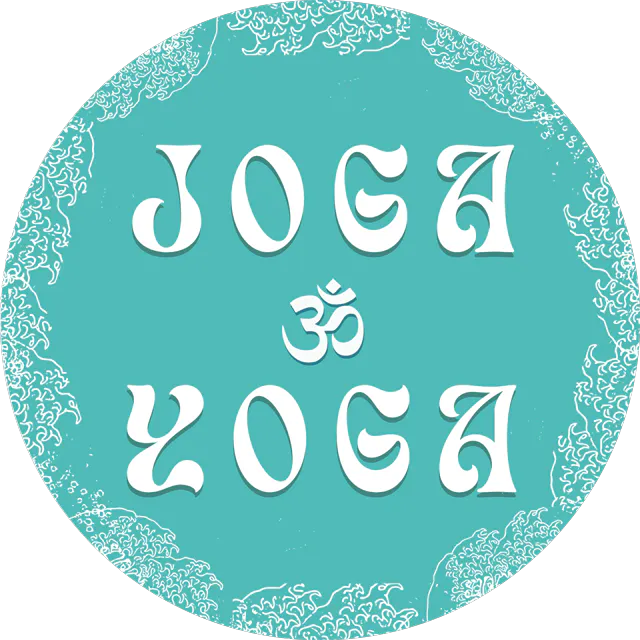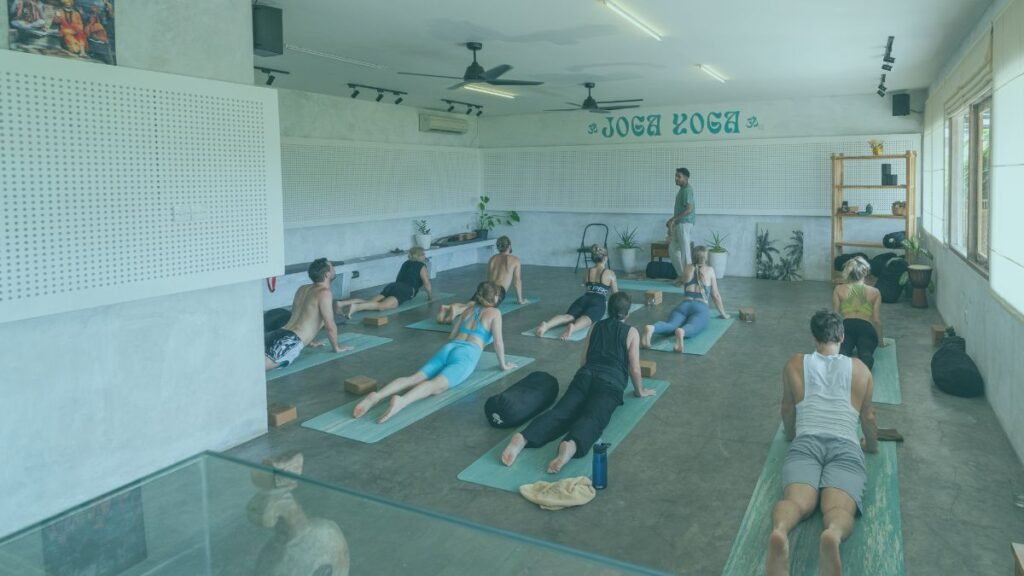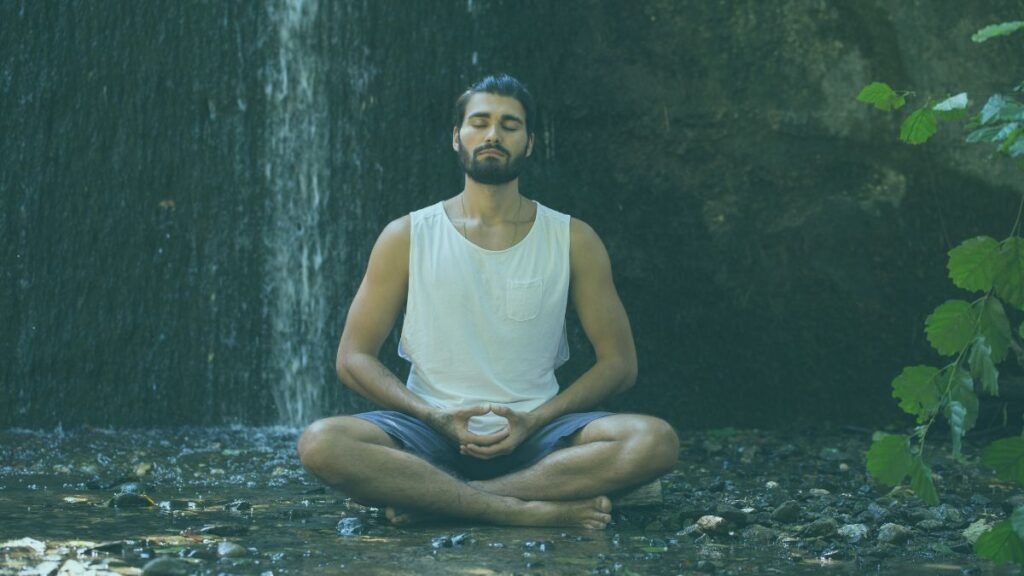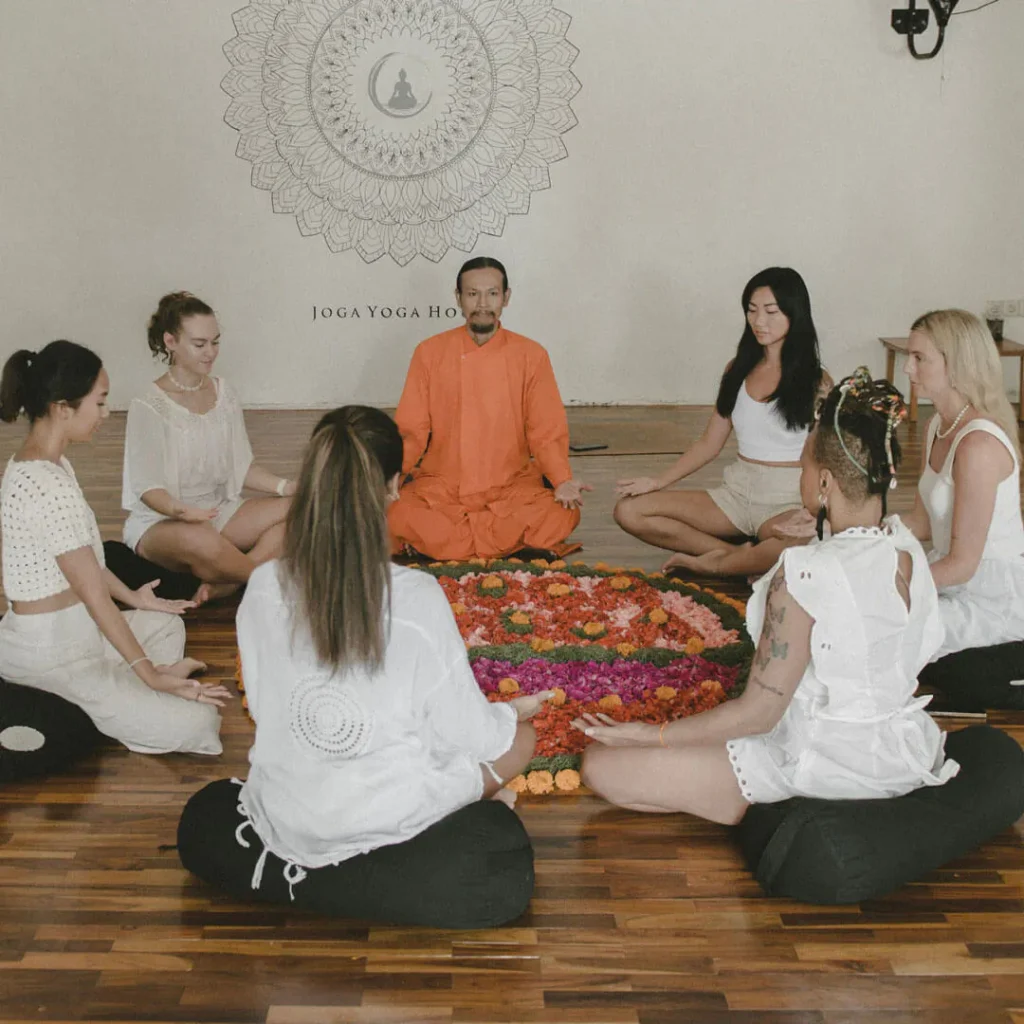What Does “Sthira Sukham Asanam” Really Mean? (Sanskrit Breakdown)
To really get what this famous line means, we need to look at each word. It’s in Sanskrit, and every part has a deeper meaning that helps us understand the bigger idea.
Sthira (स्थिर): Steady and Strong
The word sthira comes from the root word “sthā,” which means “to stand” or “to stay steady.” But it’s not just about standing still. It’s about feeling strong, stable, and balanced — not just in your body, but also in your mind. In yoga, being sthira means being calm and steady, even when things around you are busy or hard.
Sukham (सुखम्): Comfortable and Easy
Sukham is made up of two parts: “su” means “good,” and “kha” means “space.” Put together, it means something like “good space” or “a place that feels right.” In yoga, sukham is about being at ease, feeling comfortable in your body and peaceful in your mind. It’s not about being lazy, but about being kind to yourself while you practice.
Asanam (आसनम्): More Than Just a Pose
Asanam usually gets translated as “posture” or “pose.” But it actually comes from the root “ās,” which means “to sit” or “to stay.” Long ago, yoga wasn’t about doing lots of fancy poses. It was about finding a steady, comfortable place to sit so you could focus and meditate. So, asanam is really about finding a seat — a way to settle in your body and your mind.
Putting It All Together
When Patanjali said “Sthira Sukham Asanam,” he wasn’t telling us to stretch more or push harder. He was saying that a true yoga pose should feel both steady and comfortable. Not too tight, not too loose. Just right for you. It’s about being strong without being tense, and relaxed without being lazy.
Understanding the Full Message: Sutras 2.46, 2.47, and 2.48
Most people talk about the line “Sthira Sukham Asanam” from Sutra 2.46 all by itself. But Patanjali wrote it as part of a bigger idea. The next two lines — 2.47 and 2.48 — help explain what he really meant.
Sutra 2.46 – Start With a Steady and Comfortable Pose
This is the line we just talked about. A yoga pose should feel strong and easy.
Sutra 2.47 – Let Go of Effort
This next part says that once you’re in that steady pose, you should relax your effort. You don’t need to force it. The body settles, and your mind begins to focus on something bigger — something beyond the pose itself.
Sutra 2.48 – Go Beyond Distractions
After that, the third line says that when you’ve found that sweet spot — not forcing, not struggling — you stop being bothered by all the usual distractions. You’re no longer pulled around by every little thing, like hot or cold, success or failure. You feel balanced, no matter what.
Why All Three Lines Matter Together
If you just read Sutra 2.46, you might think it’s only about sitting still. But Patanjali was building a path. First, find a steady and easy position. Then, relax into it. Finally, you stop reacting to every little thing. That’s what makes it yoga, not just stretching or exercise, but learning how to be steady and calm in your whole life.
Asana ≠ Exercise: The Philosophical Error of the West
When many people in the West think of yoga, they picture a workout. Fast flows. Power poses. Sweat. But this wasn’t how yoga started. And it’s not what Patanjali meant when he wrote about asana.
Yoga Is Not Just Moving Your Body
In today’s world, yoga often gets sold like a fitness class. Studios promote “hot yoga” or “core power yoga.” It’s about burning calories or getting toned. But that idea misses the whole point.
Patanjali, the ancient teacher who wrote the Yoga Sutras, barely even talked about physical poses. In fact, asana is mentioned just a few times. And every time, it’s about finding a stable and calm place to sit, not about jumping from pose to pose.
What Patanjali Really Meant
To Patanjali, yoga was about training the mind. He believed that when your body is steady and relaxed, your thoughts become quiet. That’s where real transformation begins — inside, not outside.
Yoga wasn’t made to give you abs. It was meant to help you notice what’s going on in your mind and heart.
Fitness vs. Mindfulness
It’s not that moving your body is bad. Movement is healthy. But when we treat yoga like any other workout, we lose something important. We stop listening to our breath. We stop noticing how we feel. We chase shapes and forget presence.
True yoga is about mindfulness, not performance. It’s about how a pose makes you feel, not how it looks on Instagram.

Nervous System Intelligence: The Neuroscience of Sukha & Sthira
The idea behind sthira sukham asanam is not just about comfort and strength. It’s also about how your body and brain work together. When your posture is steady and easy, your nervous system starts to relax. That changes everything.
Meet the Vagus Nerve
You have a long nerve called the vagus nerve that runs from your brain down through your body. It helps control things like heart rate, digestion, and your ability to calm down. When this nerve is working well, you feel safe and steady. That’s called the parasympathetic response — your “rest and relax” mode.
When you sit in a comfortable, strong position and breathe slowly, your vagus nerve sends a message to your brain: “We’re safe.” That’s when your body begins to calm down.
Why Posture Matters
If you’re hunched over or tense, your body thinks something’s wrong. That triggers stress. But if you’re upright and relaxed, like in a balanced yoga pose, your nervous system shifts. Your heart rate slows down. Your muscles soften. Your brain clears up.
That’s why sthira (steadiness) and sukham (ease) aren’t just nice ideas. They change how your brain and body feel.
More Than Just Science
This is what modern science, like Polyvagal Theory, tells us. When we practice yoga the way Patanjali suggested, we’re not just stretching. We’re building emotional strength. We’re training our nervous system to stay calm, even when life gets hard.
Trauma-Informed Yoga: Applying Sthira Sukham with Sensitivity
Yoga can be powerful for healing. But when someone has been through trauma, not every pose or practice feels safe. That’s where sthira sukham asanam becomes more than just a nice idea — it becomes a guide for care.
Why Steadiness and Ease Help Heal
People who’ve gone through trauma often feel like their body isn’t a safe place to be. Their nervous system is always on high alert. So, pushing hard in a yoga class can make things worse, not better. That’s why finding steadiness (sthira) and ease (sukham) is so important. It helps create safety, not just in the body, but in the whole system.
Learning to Feel Inside: Interoception
Interoception means noticing what’s happening inside your body, like your heartbeat, breath, or muscle tension. Trauma can numb that sense. But gentle yoga, practiced with care, can help bring it back. This is key to healing, because feeling safe inside is where it all begins.
Staying in the “Window of Tolerance”
Everyone has a range where they feel okay, not too overwhelmed, and not too numb. This is called the window of tolerance. Trauma-informed yoga stays within that window. It doesn’t push you too far. It respects your limits.
That’s why sthira sukham matters. If a pose feels unsafe, we back off. If a breath feels too strong, we slow it down. We don’t force anything. Instead, we offer invitational cues — gentle suggestions like, “You’re welcome to try this if it feels right,” or “You can always rest.”
Yoga That Builds Trust
When yoga is trauma-informed, it’s not about doing more. It’s about doing what feels safe. Over time, the body learns that it can relax. The mind learns that it can focus. And slowly, healing happens through steadiness and ease.
Sthira Sukham at Work: Desk Posture Meets Ancient Wisdom
You don’t need a yoga mat to practice sthira sukham asanam. In fact, you can do it right now, sitting at your desk. That’s the beauty of this idea. It works anywhere.
Why Sitting Right Matters
Most of us spend hours at a desk. And when we slump or sit stiffly, our body gets tense, our breath gets shallow, and our brain gets tired. But if we apply the yoga idea of “steady and comfortable posture,” everything shifts.
You don’t need a perfect chair or fancy setup. You just need to notice and adjust.
Simple Desk Yoga Tips
Here’s how to bring sthira sukham into your workday:
- Feet flat on the ground. This helps you feel grounded.
- Sit tall, but not stiff. Let your spine rise naturally.
- Relax your shoulders down and back — no need to hold them tight.
- Breathe slowly. In and out through your nose. This tells your body it’s safe.
- Check in every hour. Just ask, “Do I feel steady? Do I feel at ease?”
These tiny shifts help your body stay calm and your mind stay sharp.
Take Mini Breaks with Big Impact
Even 60 seconds can make a difference. Try this:
- Sit tall.
- Close your eyes (or soften your gaze).
- Take 3 slow breaths.
- Notice how your body feels.
- Let go of any tension you find.
That’s sthira sukham in action — on the job, not just on the mat.

Micro-Mindfulness: Using 2.46 as a Breath Anchor Off the Mat
You don’t have to be on a yoga mat to practice Sthira Sukham Asanam. In fact, one of the most powerful ways to use this sutra is in everyday moments — at home, at work, even while walking or waiting in line.
Turn the Sutra Into a Breath Cue
Think of Sthira Sukham Asanam like a quiet reminder. When you feel tense or distracted, you can take a breath and say to yourself:
- “Sthira” on the inhale — feel yourself steady and grounded.
- “Sukham” on the exhale — soften, relax, let go.
This simple breath cue can bring your mind back to the present. It’s a quick way to check in with yourself and shift how you feel — from rushed to calm, from tight to open.
Use It in Journaling or Reflection
You can also use this line as a journaling theme:
- “Where in my life do I feel steady?”
- “Where do I need more ease?”
- “What can I let go of today to feel more grounded?”
This kind of reflection brings the ancient idea into your modern life, just like mindfulness practices in programs like MBSR (Mindfulness-Based Stress Reduction).
Mindfulness Off the Mat
Mindfulness isn’t just for meditation. It’s about how you eat, walk, sit, breathe — anything. And this sutra helps you bring that awareness to everything you do. Whether you’re brushing your teeth, sending emails, or playing with your kids, you can ask, “Am I steady? Am I at ease?”
That’s yoga off the mat. That’s Sthira Sukham Asanam in real life.

Frequently Asked Questions
What is the deeper meaning of Sthira Sukham Asanam?
It means that a yoga pose — and even your daily posture — should feel both steady (sthira) and comfortable (sukham). But it’s not just about the body. It’s about feeling calm and focused in your whole self.
Who defined this sutra and what was its purpose?
This sutra comes from Patanjali, a wise teacher who wrote the Yoga Sutras. His goal was to help people find peace through stillness and attention. Sthira Sukham Asanam is from the second section, where he talks about how to practice yoga.
How does this sutra apply beyond yoga poses?
You can use this idea anytime, not just in yoga class. It’s a reminder to stay balanced and relaxed in your body and mind. You can try it when sitting at your desk, standing in line, or dealing with stress.
Can I use Sthira Sukham principles at work or while sitting?
Yes, absolutely. Even small changes in how you sit or breathe can bring more comfort and focus. Sit up tall, relax your shoulders, and take slow breaths. That’s using the sutra in everyday life.






